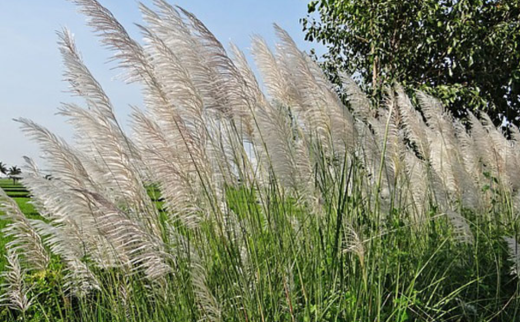Thatch Grass/ Kasha / Saccharum spontaneum Linn. – Ayurvedic Uses, Benefits, Dosage & Therapeutic Actions
Abstract
Saccharum spontaneum Linn., commonly referred to as Kasha, belongs to the Poaceae family and is native to tropical regions of Asia. Traditionally, it has been used to manage a variety of ailments, including burning sensations, obesity, indigestion, mental disorders, urinary tract infections, sexual debility and issues related to the respiratory and gynaecological systems. In Ayurveda, it is recognised for its astringent, emollient, diuretic, purgative, tonic and aphrodisiac properties. The Siddha system of medicine also values this plant for treating mental health conditions, abdominal complaints, breathlessness, anaemia and obesity.

Introduction
In ancient India, the delicate flowers of Kansa grass were ingeniously used as writing instruments, serving as natural pens to inscribe texts on traditional leaf manuscripts, a practice that highlights the cultural and historical significance of this plant. Botanically, it is known as Saccharum spontaneum and referred to as Kasha in Ayurvedic literature. This herb holds a revered place in traditional medicine. Ayurveda describes Kasha as highly beneficial in managing a range of health conditions, including burning sensations during urination, renal calculi (kidney stones), excessive menstrual bleeding (menorrhagia) and bleeding piles. Additionally, it is valued for its galactagogue property, meaning it helps enhance the production of breast milk in lactating women, thereby supporting maternal and infant health.
Scientific Classification
- Kingdom: Plantae
- Subkingdom: Tracheobionta
- Superdivision: Spermatophyta
- Division: Magnoliophyta
- Phylum: Tracheophyta
- Class: Liliopsida
- Order: Cyperales
- Family: Gramineae / Poaceae
- Genus: Saccharum
- Species: spontaneum L.
- Binomial Name: Saccharum spontaneum
Synonyms
- Kshugandha – The grass emits a scent similar to that of the sugarcane plant.
- Sita Pushpa – Bears white-colored flowers.
- Nadeya – Commonly found growing along riverbanks.
- Lekhana – Its flowers were traditionally used as pens for writing.
- Shweta Chamar Pushpa – The flowers and inflorescence resemble a white hand fan.
- Potagala
- Kandekshu
- Kakekshu
- Vayasa Ikshu
- Ikshvari
- Ikshu Kanda
- Ikshuraka
- Ikshu Kusuma
- Ikshvalika
- Darbha Patra
- Kanthala Karaka
Vernacular Names
- Hindi Name: Kasha
- English Name: Kans Grass
- Assamese Name: Khagori, Kahuva
- Bengali Name: Keshe
- Gujarati Name: Kansado
- Marathi Name: Kasai
- Telugu Name: Rellu Gaddi
- Odia Name: Kasatandi
Habitat
Saccharum spontaneum is native to tropical Asia and is commonly found in regions such as India, Southern China, Malaya and Polynesia. In India, it is widely distributed across various states, particularly along riverbanks in Andhra Pradesh and Tamil Nadu, where it thrives in moist, alluvial soil conditions.
Morphology
Saccharum spontaneum is a perennial grass characterised by slender culms that typically grow between 100–200 cm but can reach up to 4 meters in height. It has deep roots and rhizomes, forming dense clumps or continuous canebrakes through vigorous rhizomatous tillering. The leaves are linear-lanceolate with rounded bases, serrulate margins and a glaucous, involute surface. Its ligules are ovate and membranous. The plant produces long, silky white panicles with paired spikelets, one sessile and the other pedicelled, both lanceolate and reddish-brown, surrounded by long hairs. The culms are green to ivory in colour, pithy, often hollow and root at the nodes. Spikelets consist of an empty lower floret and a bisexual upper floret with three stamens and yellow or reddish anthers. The ovary is oblong with white stigmas, and the overall structure gives the plant a feathery appearance during flowering.
Classical Categorisation
1. According To Charaka Samhita
Mutravirechaniya (herbs that normalise the colour and composition of urine)
Stanyajanana (A Group of herbs that promote lactation)
2. According To Sushruta Samhita
Trina Panchamoola (Group of five medicinal grasses)
3. According To Bhavaprakash Nighantu
Guduchyadi Varga
4. According To Dhanvantari Nighantu
Karaveeradi Varga
5. According To Raj Nighantu
Shalmalyadi Varga
Ancient Verses
कासः स्यान्मधुरस्तिक्तः स्वादुपाको हिमः सरः ।
मूत्रकृच्छाश्मदाहास्त्रक्षयपित्तजरोगजित् ॥
(Bhavprakash Nighantu Guduchyadi varga 170)
According to the above shloka, Kasha has a sweet and bitter taste, the post-digestion effect is sweet and cold potency. It is effective in the management of dysuria, stones, burning sensation, bleeding disorders, tuberculosis and Pittaj Diseases.
Ayurvedic Properties
- Taste (Rasa) – Bitter (Tikta), Sweet (Madhur)
- Physical property (Guna) – Light (Laghu), Unctuous (Snigdha)
- Potency (Veerya) – Cold Potency (Sheet)
- Post-digestion effect (Vipaka) – Sweet (Madhur)
- Effect on tridosha – Balance Vata and Pitta dosha
Therapeutic Properties
- Burning sensation
- Vesical calculi (urinary bladder stones)
- Renal calculi (kidney stones)
- Painful and frequent urination
- Biliousness
- Obesity
- Galactagogue (Increases breast milk production)
- Dyspepsia (indigestion)
- Haemorrhoids (piles)
- Agalactia (absence of milk secretion)
- Phthisis (tuberculosis)
- Menorrhagia (heavy menstrual bleeding)
- Dysentery
- Mental illness
- Mental disturbances
- Urinary tract infections
- Sexual weakness
- Gynecological disorders
- Vomiting
- Abdominal disorders
- Dyspnoea (shortness of breath)
- Anaemia
Additional Uses By Parts
- Leaves – Cathartic and diuretic
- Roots – Galactagogue, diuretic
- Aerial parts – Laxative, aphrodisiac
- Stems – Used for several of the above conditions like dyspepsia, piles, menorrhagia, etc.
Systemic Actions
- Digestive System – Indicated in bleeding per rectum, bleeding hemorrhoids and indigestion due to Pitta imbalance.
- Circulatory System – Indicated in bleeding disorders and injuries to the chest.
- Reproductive System – Indicated in menorrhagia, metrorrhagia and helps in increasing breast milk production.
- Excretory System – Indicated in renal calculi and promotes urine output and helps cleanse the bladder.
- Tapakrama (Antipyretic Action) – Reduces burning sensations in the body.
- Satmikarana (Rejuvenation and Strengthening) – Indicated in generalized weakness and for strengthening the body.
Chemical Composition
- Flavonoids
- Saponins
- Triterpenoids
- Sugars (glucose, sucrose)
- Sterols
- Alkaloids
- Tannins
- Phenolic compounds
- Xylose
- Galactose
- Rhamnose
Modern Overview
Anti-Urolithiasis Activity
An ethanol root extract of Saccharum spontaneum has shown promise as an anti-urolithiasis agent in rats. This extract, administered orally at doses of 200 and 300 mg/kg, effectively restored normal levels of various indicators in rats with urolithiasis induced by glycolic acid or ethylene glycol. Specifically, it counteracted the increases in urinary urea, uric acid, calcium, oxalate and creatinine (from ethylene glycol) and sodium, potassium, chloride, protein, and lipid peroxidation (from glycolic acid) associated with the condition. Furthermore, the extract repaired altered levels of lysosomal enzymes like xanthine oxidase, β-D-glucuronidase, and n-acetyl-D-glucosaminidase in the kidney, liver, serum, and urine of the affected rats.
CNS Depressant Activity
Multiple studies point to the CNS depressant effects of various plant extracts. For instance, aqueous, ethanol, and chloroform extracts, each given orally at 1000 mg/kg, consistently lowered the locomotor activity of rats. Complementing these findings, a separate study utilizing methanol extract also reported a significant reduction in locomotor activity across open field and hole cross tests. This particular research highlighted a dose-response relationship, where the 400 mg/kg dose of the methanol extract exhibited a greater CNS depressant effect than the 200 mg/kg dose.
Antipsychotic Activity
Research has demonstrated the anti-psychotic potential of Saccharum spontaneum in male Wistar rats. In a pole climbing test, oral administration of aqueous and ethanol extracts (at 1000 mg/kg) increased the latency (or delay) for the rats to climb the pole when compared to a control group, suggesting their antipsychotic properties.
Practical Uses
- A decoction of the root of Saccharum spontaneum (Kasha), given in a dose of 50–60 ml mixed with sugar candy, is traditionally used to treat burning micturition, body heat, and excessive thirst.
- Boiling the root in cow’s milk and administering 50–60 ml is believed to enhance breast milk production in lactating women.
- In the treatment of renal calculi, a 50 ml root decoction mixed with Gokshura (Tribulus terrestris) powder is given as part of the remedy.
- For bleeding piles, a cold infusion of the root is given in a dose of 40–50 ml to help control bleeding.
- In cases of menorrhagia and blood-mixed diarrhea, a 50 ml decoction of the root is used to manage and reduce bleeding.
- Traditionally, Kansh leaves are placed with food during solar and lunar eclipses to protect it from harmful radiation.
- In North India, Kansh is used for thatching purposes. It commonly grows on barren land, riverbanks, and the borders of cultivated fields, possibly acting as a natural barrier against wild animals due to its aroma.
Part Used
- Root
Dosage
- Root powder – 50-80 ml
Ayurvedic Medicines
- Chandanadi Thailam
- Ashmarihar Kashaya
Planet Ayurveda Medicines
Conclusion
Saccharum spontaneum is a widely available, yet often underutilized herb in Ayurvedic medicine with impressive diuretic and cooling effects. Its action on urinary disorders, bleeding tendencies and Pitta-related imbalances makes it a valuable addition to holistic therapies. With growing interest in natural and preventive health systems, this humble wild grass has promising therapeutic applications validated by both traditional wisdom and phytochemical analysis.



